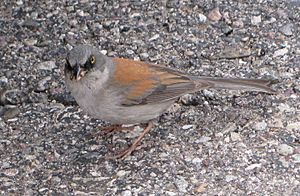Yellow-eyed junco facts for kids
Quick facts for kids Yellow-eyed junco |
|
|---|---|
 |
|
| Conservation status | |
| Scientific classification | |
| Genus: |
Junco
|
| Species: |
phaeonotus
|
 |
|
The yellow-eyed junco (Junco phaeonotus) is a small bird. It belongs to a group of birds called juncos, which are a type of New World sparrow. These birds are known for their bright yellow eyes!
You can mostly find yellow-eyed juncos in Mexico. They also live in the mountains of southern Arizona and New Mexico in the United States. These birds usually stay in one place. But sometimes, they move to lower areas during the colder winter months.
Contents
About the Yellow-Eyed Junco
Yellow-eyed juncos are small birds, but they are very active! They mostly eat seeds, berries, and insects. This helps them get all the energy they need to fly around.
Life Cycle and Reproduction
Female yellow-eyed juncos lay their eggs in a simple nest. The nest is made from dried grass and is open at the top. They usually lay three to five eggs. These eggs are a pale gray or bluish-white color.
A female junco can lay eggs two to three times each year. The eggs take about 15 days to hatch. Once the baby birds, called chicks, hatch, they grow very quickly. They are ready to leave the nest about two weeks later.
Types of Yellow-Eyed Juncos
Scientists are still learning a lot about the different types of yellow-eyed juncos. Right now, most scientists recognize four main types, also called subspecies. These types are found in different areas, mostly from north to south:
- Arizona yellow-eyed junco (J. p. palliatus)
- This type lives in the high mountains of southern Arizona, southwestern New Mexico, and northern Mexico.
- Mexican yellow-eyed junco (J. p. phaeonotus)
- Chiapas yellow-eyed junco (J. p. fulvescens)
- This type lives in the high mountains of the inner part of Chiapas, which is in southeastern Mexico.
- Guatemalan yellow-eyed junco (J. p. alticola)
Another bird, the Baird's junco (Junco bairdi), used to be thought of as a type of yellow-eyed junco. But now, scientists consider it a separate species.
See also
 In Spanish: Junco ojilumbre para niños
In Spanish: Junco ojilumbre para niños



